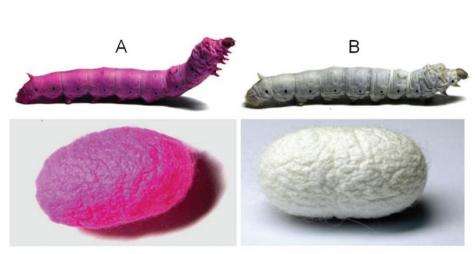March 18, 2011 report
New silkworm diet produces colored silk and possible medical advantages

(PhysOrg.com) -- The Institute of Materials Research and Engineering (IMRE) in Singapore has developed a way to replace the traditional dying process necessary to make colored silk. A simple dietary change for the silkworm larva and they are able to produce silk in a variety of colors, with the color directly integrated into the fibers.
The process designed by the researchers involves feeding a diet of mulberries treated with fluorescent dye to the silkworms in the last four days of the larva stage. Once the silkworms ingest the dye they then turn the color of the dye they were fed. The silkworms then spin their cocoon with the resulting color of the silk matching the dye they ingested.
By integrating the dye directly into the silk before it is even spun creates a more environmentally friendly process for adding color to silk. The current process of dying silk requires large amounts of water as well as chemicals, and is extremely time consuming. By refining this process to get the desired colors, the need to dye silks in the traditional way may be eliminated.
Researchers believe that this method can be adapted for large scale farms and is very cost effective. The addition of the dyes to the silkworm diet does not alter the structure of the silk itself, so once the cocoons are spun, they can be harvested and processed utilizing normal procedures.
The integration of dye into the silkworm’s diet to create a colored silk has also opened the door to other possibilities. With the strength of silk itself, it has been used for many years as sutures and wound dressings. Researchers are now looking into the possibility of adding different compounds to the silkworm diet to produce silk with antibacterial, anticoagulant, and anti-inflammatory properties.
This new research holds the benefit of not only reducing the environmental footprint by eliminating the dying process for silk, but could lead to possible breakthroughs in medical treatments and wound care.
More information: Intrinsically Colored and Luminescent Silk, by Natalia C. Tansil et al., Advanced Materials, Article first published online: 9 FEB 2011. DOI:10.1002/adma.201003860
(c) 2010 PhysOrg.com





















